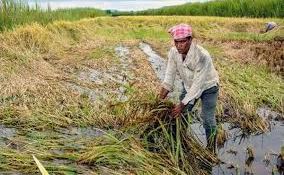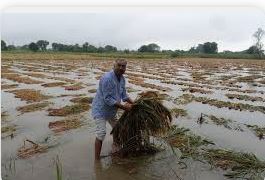

By Prasanta Ku. Dash
Among other incidents meant pivotal for Odisha recorded in 2024, during a 12-month timeline, the ‘Cyclone Dana’ had brought a socio-economic threat for the state in October last week. The IMD, the state authorities and the Union government were much worried to face the natural disaster unitedly with meticulous efforts in containing its wrath and ensuring zero casualty, optimal hit on human habitations and farm resources.
Emergent preparedness on war footings, were taken based on the IMD’s warning of a severe cyclonic circulation triggered by an intensified low pressure over the Bay of Bengal. It’s why, over 10 lakh people from the long coastal lines of the state which were more susceptible in view of cyclone were shifted to safer places anticipating devastating ravages on habitations.Similarly, all the farmers were alerted to safeguard their standing crops and green harvests, following the advices of agriculture and disaster management techies, alerting them for severe storm and incessant showers during the system. The Agriculture department issued advisories for the farmers to harvest the almost ripe paddies with other cash crops and harvestable vegetables ahead of the adverse and challenging weather.

The Cyclone Dana fortunately moved away westward and got weakened hitting violently the Bangladesh coast on the very wee hours of the fateful day. Thank God for saving the landscape and its people narrowly from a bitter and indefinite situation like the 1999 Super Cyclone and a big applaud for the Odisha government for its preparedness to withstand the tough disaster condition. However, the cyclonic form with tropical rain partly affected paddy crops, vegetables and oilseeds in Kendrapara, Jagatsinghpur, Bhadrak and Balasore district. Apart from it, rain affected cultivation in Malkangiri, Mayurbhanj and Koraput district with inundating some lowlands.

Despite Dana’s prominent and disastrous signature in the state in the early autumn, almost all districts had recorded a spectacular growth in paddy cropping for the normal monsoon rain, the state received this year. Based on the sowing areas and the overall wellbeing of the Odisha food grain staple, the Food Supply Department had planned to procure as much as double its target of paddy from the farmers this year. Accordingly, robust systems at PACS and LAMPS were adopted for effective and seamless paddy procurement even across the remote districts. Meanwhile, the Center had declared a revised MSP on paddy Rs 3100 @ quintal, in order to support the paddy croppers and sharecroppers for a sustainable living.
Unseasonal rain in year-ending December last week brought an unprecedented fury for farms and farmers all of a sudden. The Cyclone Dana, which had spared the half-grown paddy crops in millions of hectares of land across the state, have now been worst hit by the 3-day incessant rain that wreaked distress in the entire state.

As of now, million quintals of harvested paddies are being soaked in fields whereas standing paddy crops spread over millions of hectares of land are yet sinking in rainwater, floating an unseen future of farmers. The abnormal scale of rain in the winter has not only spoiled the dreams of enormous farmers but has also been a nightmare for the state to fulfill its rice load ensuring the state’s food security. On the other hand, the state and the Centre are jointly heading the tough task on how to mitigate the immense loss with sizeable compensation to the affected farmers soon, so as to ensure the food security of the green harvesters till the next yield and to help them withstand for the coming crop season.
As per the field-level survey and crop loss-assessment, conducted informally by the CM, Deputy CMs and the Revenue & Disaster Minister yet, suggest that the dreams of most of the famers ventured this year, have been perished after the winter rain.
Ultimately, the hurricaning Cyclone, Dana loosened its grip once out of mercy or by chance gusting towards West Bengal. However, the winter rain during the prime harvest days of paddy in late December has burst tears in farmers eyes, at the transit of the year 2024.